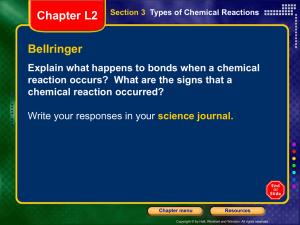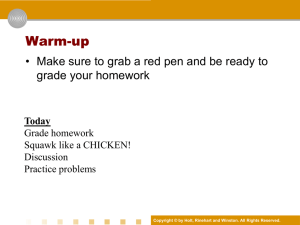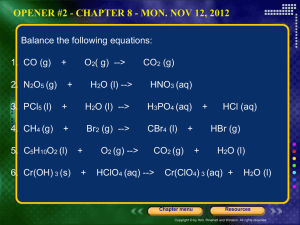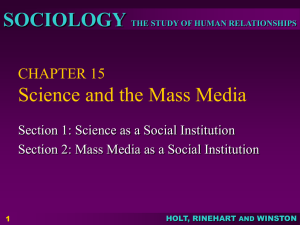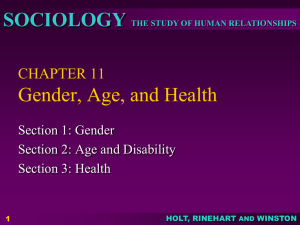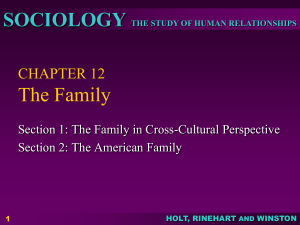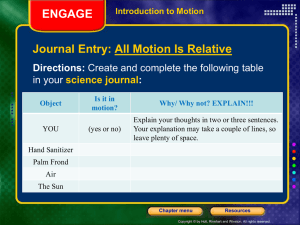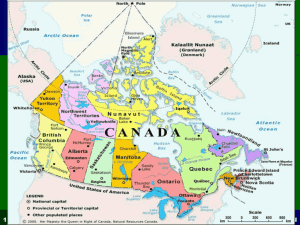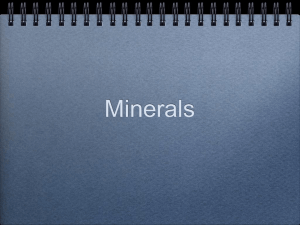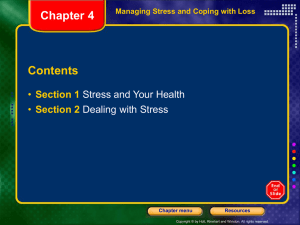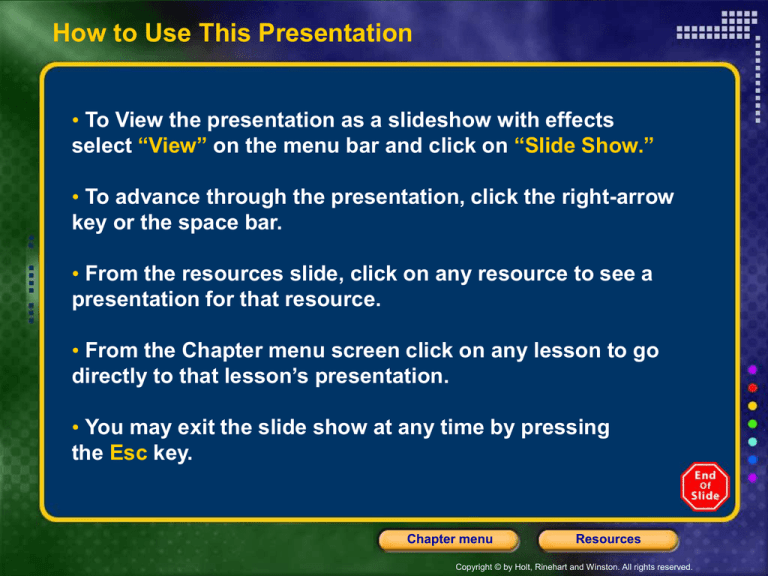
How to Use This Presentation
• To View the presentation as a slideshow with effects
select “View” on the menu bar and click on “Slide Show.”
• To advance through the presentation, click the right-arrow
key or the space bar.
• From the resources slide, click on any resource to see a
presentation for that resource.
• From the Chapter menu screen click on any lesson to go
directly to that lesson’s presentation.
• You may exit the slide show at any time by pressing
the Esc key.
Chapter menu
Resources
Copyright © by Holt, Rinehart and Winston. All rights reserved.
Resources
Bellringers
Chapter Presentation
Transparencies
Standardized Test Prep
Visual Concepts
Image and Math Focus Bank
Chapter menu
Resources
Copyright © by Holt, Rinehart and Winston. All rights reserved.
Chapter F1
Minerals of the Earth’s Crust
Table of Contents
Section 1 What Is a Mineral?
Section 2 Identifying Minerals
Section 3 The Formation, Mining, and Use of Minerals
Chapter menu
Resources
Copyright © by Holt, Rinehart and Winston. All rights reserved.
Chapter F1
Section 1 What Is a Mineral?
Bellringer
Compare the piece of pencil lead and the diamond in
the photograph provided by your teacher. Both
substances are composed of carbon. How can the
same element form two substances with such different
properties?
Record your response in your science journal.
Chapter menu
Resources
Copyright © by Holt, Rinehart and Winston. All rights reserved.
Chapter F1
Section 1 What Is a Mineral?
Objectives
• Describe the structure of minerals.
• Describe the two major groups of minerals.
Chapter menu
Resources
Copyright © by Holt, Rinehart and Winston. All rights reserved.
Chapter F1
Section 1 What Is a Mineral?
Mineral Structure
• A mineral is a naturally formed, inorganic solid
that has a definite crystalline structure.
• You can tell whether an object is a mineral by
asking four questions.
Chapter menu
Resources
Copyright © by Holt, Rinehart and Winston. All rights reserved.
Chapter F1
Section 1 What Is a Mineral?
Mineral Structure, continued
• Is it a nonliving material?
• Is it a solid?
• Does it have a crystalline structure?
• Is it formed in nature?
Chapter menu
Resources
Copyright © by Holt, Rinehart and Winston. All rights reserved.
Chapter F1
Section 1 What Is a Mineral?
Mineral Structure, continued
• To understand what a crystalline structure is, you
need to know a little about the elements that make
up a mineral.
• Elements are pure substances that cannot be
separated or broken down into simpler substances
by chemical means.
Chapter menu
Resources
Copyright © by Holt, Rinehart and Winston. All rights reserved.
Chapter F1
Section 1 What Is a Mineral?
Elements
Click below to watch the Visual Concept.
Visual Concept
You may stop the video at any time by pressing
the Esc key.
Chapter menu
Resources
Copyright © by Holt, Rinehart and Winston. All rights reserved.
Chapter F1
Section 1 What Is a Mineral?
Mineral Structure, continued
• Atoms and Compounds Minerals may be either
elements or compounds.
• A compound is a substance made of atoms of
two or more different elements joined by chemical
bonds.
Chapter menu
Resources
Copyright © by Holt, Rinehart and Winston. All rights reserved.
Chapter F1
Section 1 What Is a Mineral?
Compounds
Click below to watch the Visual Concept.
Visual Concept
You may stop the video at any time by pressing
the Esc key.
Chapter menu
Resources
Copyright © by Holt, Rinehart and Winston. All rights reserved.
Chapter F1
Section 1 What Is a Mineral?
Mineral Structure, continued
• A mineral that is composed of only one element is
called a native element.
• Gold and silver are examples of native elements.
Chapter menu
Resources
Copyright © by Holt, Rinehart and Winston. All rights reserved.
Chapter F1
Section 1 What Is a Mineral?
Mineral Structure, continued
• Solid, geometric forms of minerals produced by a
repeating pattern of atoms that is present throughout the mineral are called crystals.
• A crystal’s shape is determined by the arrangement
of the atoms within the crystal.
• The arrangement of atoms in turn is determined by
the kinds of atoms that make up the mineral.
Chapter menu
Resources
Copyright © by Holt, Rinehart and Winston. All rights reserved.
Chapter F1
Section 1 What Is a Mineral?
Two Groups of Minerals
• Minerals are divided into two groups based on their
chemical composition.
• Silicate minerals are minerals that contain a
combination of silicon, oxygen, and one or more
metals.
• Examples of silicate minerals are quartz, feldspar,
and mica.
Chapter menu
Resources
Copyright © by Holt, Rinehart and Winston. All rights reserved.
Chapter F1
Section 1 What Is a Mineral?
Two Groups of Minerals, continued
• Nonsilicate minerals are minerals that do not
contain compounds of silicon and oxygen. There
are six main classes of nonsilicate minerals.
• Native Elements
• Oxides
• Carbonates
• Sulfates
• Halides
• Sulfides
Chapter menu
Resources
Copyright © by Holt, Rinehart and Winston. All rights reserved.
Chapter F1
Section 2 Identifying Minerals
Bellringer
Look at the mineral samples provided by your
teacher. List as many phrases as you can to describe
each sample. Organize these phrases into categories
to determine whether or not each sample is a different
mineral.
Record your response in your science journal.
Chapter menu
Resources
Copyright © by Holt, Rinehart and Winston. All rights reserved.
Chapter F1
Section 2 Identifying Minerals
Objectives
• Identify seven ways to determine the identity
of minerals.
• Explain special properties of minerals.
Chapter menu
Resources
Copyright © by Holt, Rinehart and Winston. All rights reserved.
Chapter F1
Section 2 Identifying Minerals
Identifying Minerals
• You can determine the identity of a mineral by
noting different properties.
• Color Minerals display a wide variety of colors,
and often the same mineral can be found in many
different colors.
• Because of this, color is usually not the best way
to identify a mineral.
Chapter menu
Resources
Copyright © by Holt, Rinehart and Winston. All rights reserved.
Chapter F1
Section 2 Identifying Minerals
Identifying Minerals, continued
• The way a mineral reflects light is called luster.
There are three types of mineral luster:
• Metallic
• Submetallic
• Nonmetallic
Chapter menu
Resources
Copyright © by Holt, Rinehart and Winston. All rights reserved.
Chapter F1
Section 2 Identifying Minerals
Identifying Minerals, continued
• The color of a mineral in powdered form is called
the mineral’s streak.
• A mineral’s streak can be found by running the
mineral against a piece of unglazed porcelain
called a streak plate.
• The color of a mineral’s streak is not always the
same as the color of the mineral sample.
Chapter menu
Resources
Copyright © by Holt, Rinehart and Winston. All rights reserved.
Chapter F1
Section 2 Identifying Minerals
Mineral Color, Luster, and Streak
Click below to watch the Visual Concept.
Visual Concept
You may stop the video at any time by pressing
the Esc key.
Chapter menu
Resources
Copyright © by Holt, Rinehart and Winston. All rights reserved.
Chapter F1
Section 2 Identifying Minerals
Cleavage and Fracture
• Different types of minerals break in different ways.
• Cleavage is the tendency of some minerals to
break along smooth, flat surfaces.
• Fracture is the tendency of some minerals to
break unevenly along curved or irregular surfaces.
Chapter menu
Resources
Copyright © by Holt, Rinehart and Winston. All rights reserved.
Chapter F1
Section 2 Identifying Minerals
Hardness
• A mineral’s resistance to being scratched is called
hardness.
• To determine the hardness of minerals, scientists
use Mohs hardness scale, shown on the next slide.
Chapter menu
Resources
Copyright © by Holt, Rinehart and Winston. All rights reserved.
Chapter F1
Section 2 Identifying Minerals
Chapter menu
Resources
Copyright © by Holt, Rinehart and Winston. All rights reserved.
Chapter F1
Section 2 Identifying Minerals
Density
• Density is the measure of how much matter is
in a given amount of space. Density is a ratio of
an object’s mass to its volume.
• Different minerals have different densities.
Chapter menu
Resources
Copyright © by Holt, Rinehart and Winston. All rights reserved.
Chapter F1
Section 2 Identifying Minerals
Special Properties
• Some properties are particular to only a few types
of minerals.
• The properties shown on the next slide can help
you quickly identify some minerals.
Chapter menu
Resources
Copyright © by Holt, Rinehart and Winston. All rights reserved.
Chapter F1
Section 2 Identifying Minerals
Chapter menu
Resources
Copyright © by Holt, Rinehart and Winston. All rights reserved.
Chapter F1
Section 3 The Formation, Mining, and Use of
Minerals
Bellringer
Look at a mineral resource map of your state
and locate the mines closest to where you live.
Which mineral commodities are mined there?
Write your response in your science journal.
Chapter menu
Resources
Copyright © by Holt, Rinehart and Winston. All rights reserved.
Chapter F1
Section 3 The Formation, Mining, and Use of
Minerals
Objectives
• Describe the environments in which minerals
forms.
• Compare the two types of mining.
• Describe two ways to reduce the effects of
mining.
• Describe different uses for metallic and
nonmetallic minerals.
Chapter menu
Resources
Copyright © by Holt, Rinehart and Winston. All rights reserved.
Chapter F1
Section 3 The Formation, Mining, and Use of
Minerals
Formation of Minerals
• Minerals form in a variety of environments in the
Earth’s crust. Each environment has a different set
of physical and chemical conditions that determine
the minerals’ properties.
• Evaporating Salt Water When a body of salt
water dries up, minerals such as gypsum and halite
are left behind.
Chapter menu
Resources
Copyright © by Holt, Rinehart and Winston. All rights reserved.
Chapter F1
Section 3 The Formation, Mining, and Use of
Minerals
Formation of Minerals, continued
• Metamorphic Rocks When changes in pressure,
temperature, or chemical makeup alter a rock,
metamorphism takes place.
• Minerals that form in metamorphic rock include
calcite, garnet, graphite, hematite, magnetite, mica,
and talc.
Chapter menu
Resources
Copyright © by Holt, Rinehart and Winston. All rights reserved.
Chapter F1
Section 3 The Formation, Mining, and Use of
Minerals
Formation of Minerals, continued
• Limestones Surface water and groundwater
carry dissolved materials into lakes and seas,
where they crystallized on the bottom.
• Minerals that form in this environment include
calcite and dolomite.
Chapter menu
Resources
Copyright © by Holt, Rinehart and Winston. All rights reserved.
Chapter F1
Section 3 The Formation, Mining, and Use of
Minerals
Formation of Minerals, continued
• Hot-Water Solutions Groundwater works its way
downward and is heated by magma, and then
reacts with minerals to form a hot liquid solution.
• Dissolved metals and other elements crystallize
out of the hot fluid to form new minerals, such as
gold, copper, sulfur, pyrite, and galena.
Chapter menu
Resources
Copyright © by Holt, Rinehart and Winston. All rights reserved.
Chapter F1
Section 3 The Formation, Mining, and Use of
Minerals
Formation of Minerals, continued
• Pegmatites As magma rises upward from the
Earth’s crust, it can form teardrop-shaped bodies
called pegmatites.
• Many gemstones such as topaz and tourmaline,
form in pegmatites.
Chapter menu
Resources
Copyright © by Holt, Rinehart and Winston. All rights reserved.
Chapter F1
Section 3 The Formation, Mining, and Use of
Minerals
Formation of Minerals, continued
• Plutons As magma rises upward through the
crust, it sometimes stops moving before it reaches
the surface and cools slowly, forming millions of
mineral crystals.
• Eventually, the entire magma body solidifies,
forming minerals such as mica, feldspar, magnetite,
and quartz.
Chapter menu
Resources
Copyright © by Holt, Rinehart and Winston. All rights reserved.
Chapter F1
Section 3 The Formation, Mining, and Use of
Minerals
Mining
• Many kinds of rocks and minerals must be mined
to extract the valuable elements they contain.
• Geologists use the term ore to describe a mineral
deposit large enough and pure enough to be mined
for profit.
• Rocks and minerals are removed from the ground
by one of two methods.
Chapter menu
Resources
Copyright © by Holt, Rinehart and Winston. All rights reserved.
Chapter F1
Section 3 The Formation, Mining, and Use of
Minerals
Mining, continued
• Surface Mining When mineral deposits are
located at or near the surface of the Earth, surfacemining methods are used to remove the minerals.
• Types of surface mines include open pits, surface
coal mines, and quarries.
Chapter menu
Resources
Copyright © by Holt, Rinehart and Winston. All rights reserved.
Chapter F1
Section 3 The Formation, Mining, and Use of
Minerals
Mining, continued
• Subsurface Mining methods are used when
mineral deposits are located too deep within the
Earth to be surface mined.
• Subsurface mining often requires that passageways
be dug into the Earth to reach the ore.
Chapter menu
Resources
Copyright © by Holt, Rinehart and Winston. All rights reserved.
Chapter F1
Section 3 The Formation, Mining, and Use of
Minerals
Responsible Mining
• Mining gives us the minerals we need, but it may
also create problems.
• Mining can destroy or disturb the habitats of plants
and animals.
• Waste products from a mine may get into water
sources, which pollutes surface water and ground
water.
Chapter menu
Resources
Copyright © by Holt, Rinehart and Winston. All rights reserved.
Chapter F1
Section 3 The Formation, Mining, and Use of
Minerals
Responsible Mining, continued
• One way to reduce the potential harmful effects
of mining is to return the land to its original state
after the mining is completed.
• Reclamation is the process by which land used
for mining is returned to its original state.
• Reducing our need for minerals by recycling is
another way to reduce the effects of mining.
Chapter menu
Resources
Copyright © by Holt, Rinehart and Winston. All rights reserved.
Chapter F1
Section 3 The Formation, Mining, and Use of
Minerals
The Use of Minerals
• Metallic Minerals are good conductors of heat
and electricity. They can be processed for various
uses, including building aircraft, automobiles, and
communications and electronic equipment.
• Examples of useful metallic minerals include gold,
silver, and copper.
Chapter menu
Resources
Copyright © by Holt, Rinehart and Winston. All rights reserved.
Chapter F1
Section 3 The Formation, Mining, and Use of
Minerals
The Use of Minerals, continued
• Nonmetallic Minerals are good insulators of
electricity. They have uses that range from glassmaking to producing computer chips.
• Calcite, one nonmetallic mineral, is a major
component of concrete, which is used in building
roads, buildings, bridges and other structures.
Chapter menu
Resources
Copyright © by Holt, Rinehart and Winston. All rights reserved.
Chapter F1
Section 3 The Formation, Mining, and Use of
Minerals
The Use of Minerals, continued
• Gemstones are highly valued for their beauty and
rarity, than for their usefulness.
• Important gemstones include diamond, sapphire,
ruby, emerald, aquamarine, topaz, and tourmaline.
Chapter menu
Resources
Copyright © by Holt, Rinehart and Winston. All rights reserved.
Chapter F1
Minerals of the Earth’s Crust
Concept Map
Use the terms below to complete the concept map on
the next slide.
gems
compounds
atoms
mineral ore
mining
minerals
diamonds
Chapter menu
Resources
Copyright © by Holt, Rinehart and Winston. All rights reserved.
Chapter F1
Minerals of the Earth’s Crust
Chapter menu
Resources
Copyright © by Holt, Rinehart and Winston. All rights reserved.
Chapter F1
Minerals of the Earth’s Crust
Chapter menu
Resources
Copyright © by Holt, Rinehart and Winston. All rights reserved.
End of Chapter F1 Show
Chapter menu
Resources
Copyright © by Holt, Rinehart and Winston. All rights reserved.
Chapter F1
Standardized Test Preparation
Reading
Read each of the passages. Then, answer the
questions that follow each passage.
Chapter menu
Resources
Copyright © by Holt, Rinehart and Winston. All rights reserved.
Chapter F1
Standardized Test Preparation
Passage 1 In North America, copper was mined at
least 6,700 years ago by the ancestors of the Native
Americans who live on Michigan’s upper peninsula.
Much of this mining took place on Isle Royale, an island
in Lake Superior. These ancient people removed
copper from the rock by using stone hammers and
wedges. The rock was sometimes heated first to make
breaking it up easier.
Continued on the next slide
Chapter menu
Resources
Copyright © by Holt, Rinehart and Winston. All rights reserved.
Chapter F1
Standardized Test Preparation
Passage 1, continued Copper that was mined was
used to make jewelry, tools, weapons, fish hooks, and
other objects. These objects were often marked with
designs. The Lake Superior copper was traded over
long distances along ancient trade routes. Copper
objects have been found in Ohio, Florida, the
Southwest, and the Northwest.
Chapter menu
Resources
Copyright © by Holt, Rinehart and Winston. All rights reserved.
Chapter F1
Standardized Test Preparation
1. In the passage, what does ancient mean?
A young
B future
C modern
D early
Chapter menu
Resources
Copyright © by Holt, Rinehart and Winston. All rights reserved.
Chapter F1
Standardized Test Preparation
1. In the passage, what does ancient mean?
A young
B future
C modern
D early
Chapter menu
Resources
Copyright © by Holt, Rinehart and Winston. All rights reserved.
Chapter F1
Standardized Test Preparation
2. According to the passage, what did the ancient
copper miners do?
F They mined copper in Ohio, Florida, the Southwest,
and the Northwest.
G They mined copper by cooling the rock in which the
copper was found.
H They mined copper by using stone tools.
I They mined copper for their use only.
Chapter menu
Resources
Copyright © by Holt, Rinehart and Winston. All rights reserved.
Chapter F1
Standardized Test Preparation
2. According to the passage, what did the ancient
copper miners do?
F They mined copper in Ohio, Florida, the Southwest,
and the Northwest.
G They mined copper by cooling the rock in which the
copper was found.
H They mined copper by using stone tools.
I They mined copper for their use only.
Chapter menu
Resources
Copyright © by Holt, Rinehart and Winston. All rights reserved.
Chapter F1
Standardized Test Preparation
3. Which of the following statements is a fact according
to the passage?
A Copper could be shaped into different objects.
B Copper was unknown outside of Michigan’s upper
peninsula.
C Copper could be mined easily from the rock in which
it was found.
D Copper could not be marked with designs.
Chapter menu
Resources
Copyright © by Holt, Rinehart and Winston. All rights reserved.
Chapter F1
Standardized Test Preparation
3. Which of the following statements is a fact according
to the passage?
A Copper could be shaped into different objects.
B Copper was unknown outside of Michigan’s upper
peninsula.
C Copper could be mined easily from the rock in which
it was found.
D Copper could not be marked with designs.
Chapter menu
Resources
Copyright © by Holt, Rinehart and Winston. All rights reserved.
Chapter F1
Standardized Test Preparation
Passage 2 Most mineral names end in -ite. The
practice of so naming minerals dates back to the
ancient Romans and Greeks, who added -ites and -it
is to common words to indicate a color, a use, or the
chemistry of a mineral. More recently, mineral names
have been used to honor people, such as scientists,
mineral collectors, and even rulers of countries. Other
minerals have been named after the place where they
were discovered. These place names include mines,
quarries, hills, mountains, towns, regions, and even
countries. Finally, some minerals have been named
after gods in Greek, Roman, and Scandinavian
mythology.
Chapter menu
Resources
Copyright © by Holt, Rinehart and Winston. All rights reserved.
Chapter F1
Standardized Test Preparation
1. In the passage, what does practice mean?
A skill
B custom
C profession
D use
Chapter menu
Resources
Copyright © by Holt, Rinehart and Winston. All rights reserved.
Chapter F1
Standardized Test Preparation
1. In the passage, what does practice mean?
A skill
B custom
C profession
D use
Chapter menu
Resources
Copyright © by Holt, Rinehart and Winston. All rights reserved.
Chapter F1
Standardized Test Preparation
2. According to the passage, the ancient Greeks and
Romans did not name minerals after what?
F colors
G chemical properties
H people
I uses
Chapter menu
Resources
Copyright © by Holt, Rinehart and Winston. All rights reserved.
Chapter F1
Standardized Test Preparation
2. According to the passage, the ancient Greeks and
Romans did not name minerals after what?
F colors
G chemical properties
H people
I uses
Chapter menu
Resources
Copyright © by Holt, Rinehart and Winston. All rights reserved.
Chapter F1
Standardized Test Preparation
3. Which of the following statements is a fact
according to the passage?
A Minerals are sometimes named for the country in
which they are discovered.
B Minerals are never named after their collectors.
C All mineral names end in -ite.
D All of the known minerals were named by the
Greeks and Romans.
Chapter menu
Resources
Copyright © by Holt, Rinehart and Winston. All rights reserved.
Chapter F1
Standardized Test Preparation
3. Which of the following statements is a fact
according to the passage?
A Minerals are sometimes named for the country in
which they are discovered.
B Minerals are never named after their collectors.
C All mineral names end in -ite.
D All of the known minerals were named by the
Greeks and Romans.
Chapter menu
Resources
Copyright © by Holt, Rinehart and Winston. All rights reserved.
Chapter F1
Standardized Test Preparation
Interpreting Graphics
A sample of feldspar was analyzed to find out what it
was made of. The graph below shows the results of the
analysis. Use the graph below to answer the questions
that follow.
Chapter menu
Resources
Copyright © by Holt, Rinehart and Winston. All rights reserved.
Chapter F1
Standardized Test Preparation
1. The sample consists of
four elements: potassium,
K, aluminum, Al, silicon,
Si, and oxygen, O. Which
element makes up the
largest percentage of your
sample?
A potassium
B aluminum
C silicon
D oxygen
Chapter menu
Resources
Copyright © by Holt, Rinehart and Winston. All rights reserved.
Chapter F1
Standardized Test Preparation
1. The sample consists of
four elements: potassium,
K, aluminum, Al, silicon,
Si, and oxygen, O. Which
element makes up the
largest percentage of your
sample?
A potassium
B aluminum
C silicon
D oxygen
Chapter menu
Resources
Copyright © by Holt, Rinehart and Winston. All rights reserved.
Chapter F1
Standardized Test Preparation
2. Silicate minerals, such as feldspar, contain a
combination of silicon and oxygen. What percentage of
your sample is composed of silicon and oxygen
combined?
F 30%
G 40%
H 50%
I 70%
Chapter menu
Resources
Copyright © by Holt, Rinehart and Winston. All rights reserved.
Chapter F1
Standardized Test Preparation
2. Silicate minerals, such as feldspar, contain a
combination of silicon and oxygen. What percentage of
your sample is composed of silicon and oxygen
combined?
F 30%
G 40%
H 50%
I 70%
Chapter menu
Resources
Copyright © by Holt, Rinehart and Winston. All rights reserved.
Chapter F1
Standardized Test Preparation
3. If your sample
has a mass of 10 g,
how many grams of
oxygen does it
contain?
A1g
B2g
C4g
D8g
Chapter menu
Resources
Copyright © by Holt, Rinehart and Winston. All rights reserved.
Chapter F1
Standardized Test Preparation
3. If your sample
has a mass of 10 g,
how many grams of
oxygen does it
contain?
A1g
B2g
C4g
D8g
Chapter menu
Resources
Copyright © by Holt, Rinehart and Winston. All rights reserved.
Chapter F1
Standardized Test Preparation
4. Your sample of
orthoclase has a
hardness of 6. Which
of the following
minerals will scratch
your sample?
F gypsum
G corundum
H calcite
I apatite
Chapter menu
Resources
Copyright © by Holt, Rinehart and Winston. All rights reserved.
Chapter F1
Standardized Test Preparation
4. Your sample of
orthoclase has a
hardness of 6. Which
of the following
minerals will scratch
your sample?
F gypsum
G corundum
H calcite
I apatite
Chapter menu
Resources
Copyright © by Holt, Rinehart and Winston. All rights reserved.
Chapter F1
Standardized Test Preparation
Math
Read each question, and choose the best answer.
Chapter menu
Resources
Copyright © by Holt, Rinehart and Winston. All rights reserved.
Chapter F1
Standardized Test Preparation
1. Gold classified as 24-karat is 100% gold. Gold
classified as 18-karat is 18 parts gold and 6 parts
another, similar metal. The gold is therefore 18/24,
or 3/4, pure. What is the percentage of pure gold in
18-karat gold?
A 10%
B 25%
C 50%
D 75%
Chapter menu
Resources
Copyright © by Holt, Rinehart and Winston. All rights reserved.
Chapter F1
Standardized Test Preparation
1. Gold classified as 24-karat is 100% gold. Gold
classified as 18-karat is 18 parts gold and 6 parts
another, similar metal. The gold is therefore 18/24,
or 3/4, pure. What is the percentage of pure gold in
18-karat gold?
A 10%
B 25%
C 50%
D 75%
Chapter menu
Resources
Copyright © by Holt, Rinehart and Winston. All rights reserved.
Chapter F1
Standardized Test Preparation
2. Gold’s specific gravity is 19. Pyrite’s specific gravity
is 5. What is the difference in the specific gravities of
gold and pyrite?
F 8 g/cm3
G 10 g/cm3
H 12 g/cm3
I 14 g/cm3
Chapter menu
Resources
Copyright © by Holt, Rinehart and Winston. All rights reserved.
Chapter F1
Standardized Test Preparation
2. Gold’s specific gravity is 19. Pyrite’s specific gravity
is 5. What is the difference in the specific gravities of
gold and pyrite?
F 8 g/cm3
G 10 g/cm3
H 12 g/cm3
I 14 g/cm3
Chapter menu
Resources
Copyright © by Holt, Rinehart and Winston. All rights reserved.
Chapter F1
Standardized Test Preparation
3. In a quartz crystal, there is one silicon atom for every
two oxygen atoms. So, the ratio of silicon atoms to
oxygen atoms is 1:2. If there were 8 million oxygen
atoms in a sample of quartz, how many silicon atoms
would there be in the sample?
A 2 million
B 4 million
C 8 million
D 16 million
Chapter menu
Resources
Copyright © by Holt, Rinehart and Winston. All rights reserved.
Chapter F1
Standardized Test Preparation
3. In a quartz crystal, there is one silicon atom for every
two oxygen atoms. So, the ratio of silicon atoms to
oxygen atoms is 1:2. If there were 8 million oxygen
atoms in a sample of quartz, how many silicon atoms
would there be in the sample?
A 2 million
B 4 million
C 8 million
D 16 million
Chapter menu
Resources
Copyright © by Holt, Rinehart and Winston. All rights reserved.
Chapter F1
Standardized Test Preparation
Chapter menu
Resources
Copyright © by Holt, Rinehart and Winston. All rights reserved.

